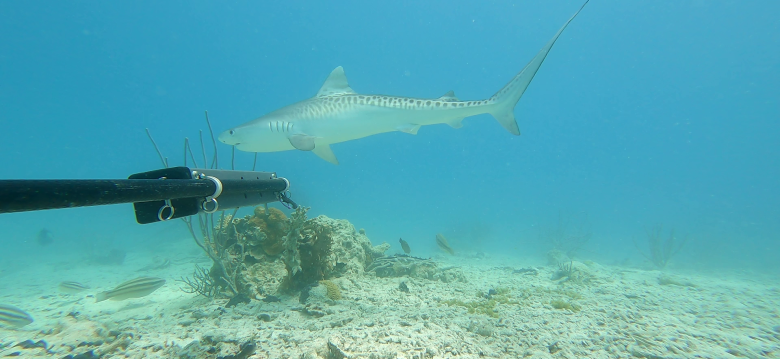
Using a Baited Remote Underwater Video System (BRUVS) with dual mounted cameras, marine scientists have been capturing footage of the pelagic fish community in Bermuda. In efforts to evidence Bermuda’s ocean biodiversity and ecosystems, the Department of Environment and Natural Resources (DENR) hosted Dr Jason Meeuwig of Blue Abacus to enable the deployment of a number of BRUVS in areas of sensitive habitats.
Dr Jason Meeuwig of Blue Abacus said "Deploying BRUVS allows us to get a visual and scientific understanding of what is going on beneath the surface of the water, providing the people of Bermuda an opportunity to make informed decisions about their critical marine resources."
The Governor joined Dr Meeuwig and DENR marine scientists to observe and assist with the deployment of the BRUVS. The BRUVS are mostly made of carbon fibre, with special design and weighting to keep them in position. The cameras record marine life in their vicinity, attracted by bait held in a perforated container.
Supported by the Coastguard, the group visited a number of locations where they launched the BRUVS from a boat. The BRUVS were then left in the ocean for 1-2 hours before being retrieved and the data from the cameras downloaded. Marine scientists then study the footage, identify the species and count how many of each species are seen. The use of dual mounted cameras means that fish can be sized as well as counted.
On return to shore, the Governor was also able to view footage of species seen in the Bermuda waters, which included a juvenile tiger shark. Bermuda is one of ten Overseas Territories documenting the status of their open ocean wildlife through the Global Ocean Wildlife Analysis Network (GOWAN), to build ocean resilience. The data produced will provide DENR with the evidence needed to monitor and sustainably manage the marine environment around Bermuda.
Governor Andrew Murdoch CMG said: ‘The deployment of UK funds through the Blue Belt programme is designed to support the Overseas Territories in understanding their marine environment better. The strategic deployment of these innovative underwater devices can assist the Government of Bermuda in obtaining more accurate data on which to base their future policy decisions. This work by Blue Abacus will give DENR more data to build a fuller understanding of Bermuda’s marine ecosystems.’
Background
GOWAN, funded by the UK Government’s Blue Belt Ocean Shield programme, concentrates on pelagic fish (which live in the middle and upper sections of the water column and includes threatened species such as oceanic sharks, tunas, billfishes and forage species) as these are the base of resilient oceans.
To date BRUVS have identified, counted and measured more than 135,000 pelagic fish and sharks from more than 30 locations. BRUVS in Tristan da Cunha have recorded the first underwater sighting of the elusive Shepherd’s beaked whale at the appropriately-named Inaccessible Island; at Ascension Island, seamounts were clearly identified as biodiversity hotspots but roaming species like blue sharks, one of the most heavily exploited sharks globally, were most strongly associated with open ocean areas providing strong evidence for the need for large-scale protection rather than only localised protection at physical features like seamounts.
The Global Ocean Wildlife Analysis Network (GOWAN), is spearheading the data gathering effort across the Atlantic, Indian, Pacific and Southern Oceans. Working in collaboration with local governments and delivery partner Blue Abacus, Cefas scientists (the UK government’s marine and freshwater experts) and the Marine Management Organisation (who support sustainable development of the UK’s seas and coasts), are increasing our knowledge of what lies beneath Bermuda’s curtain with their underwater camera network.
